Parasites of Backyard Chickens
Thomas M. Craig, DVM, PhD, DACVM, Texas A&M University
Jessica Y. Rodriguez, DVM, Texas A&M University
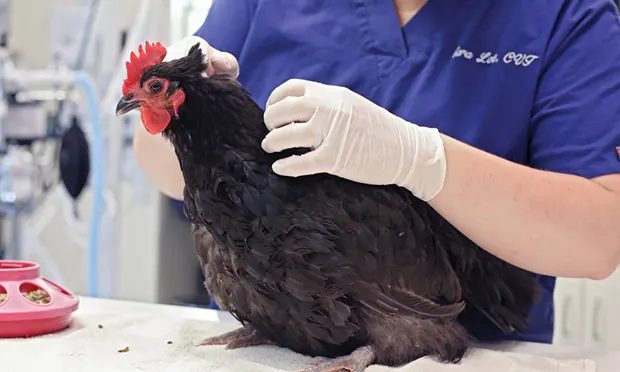
Overview
Susceptibility and pathogenicity of common parasites of the backyard chicken (Gallus gallus) may differ from those seen in other backyard bird species (eg, turkeys, peafowl); appropriate medication and dosages may also differ.<sup1 sup>
This review focuses on how these parasites affect backyard chickens.
A survey study of necropsied backyard chickens in southern California showed that parasitic infection was responsible for 5% of deaths.2
Housing conditions, population density of birds, and introduction of new birds can affect the intensity of parasitism and subsequent disease.
Biosecurity practices are often limited and can contribute to risks.
In a survey of backyard flock owners in Colorado, 40% did not quarantine new birds.3
Young birds are frequently more affected by parasites and should be separated from older birds.
Veterinarians should educate backyard poultry owners about potential parasitic zoonoses.4
The relative prevalence of these parasites varies geographically.
A local veterinary extension specialist or equivalent poultry veterinarian advisor can help educate veterinarians and backyard chicken owners on parasites commonly seen in their areas.
Ectoparasites
Lice, fleas, and mites can enter backyard poultry premises via infected newly introduced birds, as well as on wild birds and rodents.5,6
Removing wild bird feeders; keeping premises clean of feed; preventing contact with wild birds (eg, netting); and quarantining, testing, and treating new birds can reduce these exposures.
Lice and mites are the most common ectoparasites of backyard fowl (see Table).
The presence of these ectoparasites has been associated with poor weight gain, reduced egg production, and death.<sup7 sup>
Studies have implicated ectoparasite-associated transmission of infectious agents.8
Heavy infestations are more likely to lead to negative effects on the host.
It is important to examine the cloaca for evidence of ectoparasites.
Interval treatment of the host and premises based on the parasite’s life cycle length is necessary to resolve flock infestations.
Comparison of Dermanyssus gallinae, Ornithonyssus spp, & Poultry Lice
*In an unfed state, adult mites can survive for long periods of time.
Poultry Lice
Lice commonly infest backyard chickens (Figure 1).
All poultry lice are chewing lice, and chickens can host more than one species at the same time.9,10
Although species in the Ischnocera suborder tend to only cause feather damage, members of Amblycera (Menacanthus stramineus and M cornutus) tend to chew on skin and feather quills, which causes blood loss and skin lesions.10
In general, most species of lice are found on the abdomen (including the cloaca), breast, and back.
Some species can be found on the neck, wings, and tail.9
During physical examination, note that the number of lice eggs found in clusters at the base of feather shafts can greatly outnumber adults.11,12
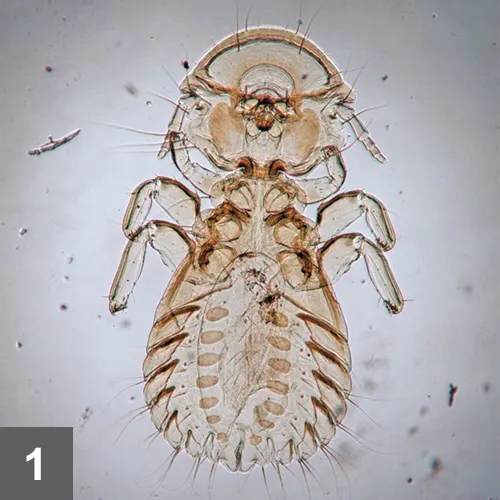
Poultry louse, 20× magnification. Lice species vary in size and shape, but the presence of antennae and 6 legs will help in identification of a louse. They are approximately 2 mm to 4 mm in length and can be visualized on the host with careful examination.
Dermanyssus gallinae (Red Poultry Mite)
These mites feed on blood; heavy infestations can cause anemia, decreased weight, and death.8
The parasite lives in cracks and crevices near the resting area of the chicken; it feeds at night.
Heavy infestations can alter where the chicken sleeps.7
Owners may need to retrieve specimens from housing or from chickens at night to determine infestation.
Mites can increase in numbers quickly and survive for up to 34 weeks without feeding, which can require treatment of the premises.13
These mites can feed on humans and can cause papular dermatitis.14
Ornithonyssus sylviarum (Northern Fowl Mite) & O bursa (Tropical Fowl Mite)
Like the red poultry mite, these mites feed on blood and cause similar clinical signs.
In one study, mites were found most commonly on the the cloaca, breast, and thighs (Figure 2).15
Mites are found less commonly on the head and neck.15
Mites, mite eggs, and mite excrement can be seen along the feather shafts.
The entire life cycle occurs on the host within 5-7 days.15
Survival off the host is only 21 days, but this is long enough for mites to be transported through fomites.13
Like D gallinae, this mite can also cause a self-limiting dermatitis in humans.14
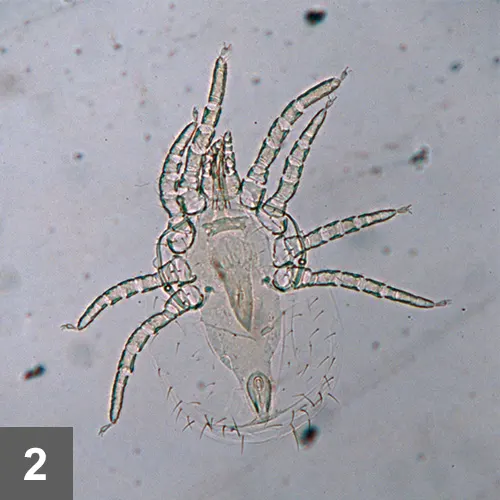
Ornithonyssus sp, 40× magnification. Fresh specimens will have a red/brown pigment from blood ingestion. At less than 1 mm in length, visualization of this mite is more difficult than visualizing lice on the host.
Feather Mites
This group of mites consists of many species in several genera that can infect a variety of wild and domesticated birds.
Loss of feathers and skin lesions have been associated with species that feed on skin and quills, especially when mite numbers are high.
These mites may be confused with O sylvarium because they feed and live on the host and can also cause skin lesions.16
Knemidocoptes mutans (Scaly Leg Mite)
These mites tend to cause disease in older chickens.
Subtle signs of lifting of scales can be seen before crusting, thickening, and severe disfigurative disease of the legs occur.
Deep skin scrapings of affected areas can recover small, round mites with short legs.17
Echidnophaga gallinacea (Sticktight Flea)
Large numbers of fleas can cause death—especially in young chickens—from anemia and secondary infection from the bite lesions (Figure 3).
Female fleas localize on the head and remain attached during feeding, which causes crusted lesions.18
These fleas are more commonly seen in warm and humid regions.
Wildlife, dogs, cats, and humans in the vicinity of infested flocks are also susceptible.
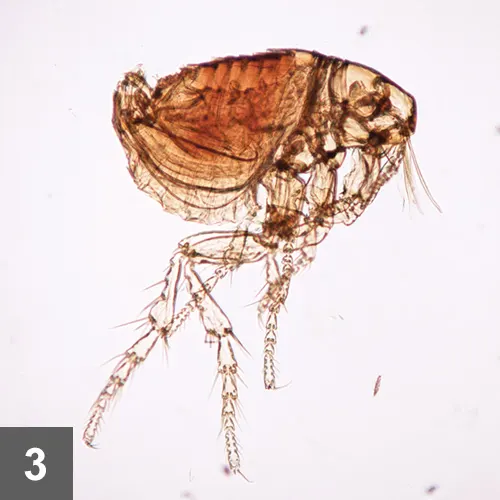
Echidnophaga gallinacea, 40× magnification. The anterior end of the head of the flea is flattened, which differs from the rounded head of the cat flea (Ctenocephalides felis). These fleas remain attached during feeding and may be confused with ticks.
Other Ectoparasites
Chickens able to roam in tall grass and wooded areas may be exposed to tick species as well as chigger mites (Trombiculidae).
Argas persicus (fowl tick) is a soft tick that lives in the housing during the day and feeds at night; this can cause disturbances to chickens and alter where they sleep.
Biting flies in large numbers can also be disruptive to chickens.
Endoparasites
Backyard chickens are highly susceptible to endoparasites because of contact with soil that can harbor hardy parasite eggs and ingestion of potential intermediate hosts.
Prompt feces removal, pen rotation, and pest control can help reduce exposure.
In a survey of backyard flocks in Michigan, only 1 of 12 flocks were free from intestinal parasites.19
The most commonly identified intestinal parasites by fecal examination were coccidia (Figures 4 and 5), ascarids, and Capillaria spp (Figure 6).19
Fecal flotation, gross visualization of helminths in feces, and necropsies can be used to diagnose GI parasitic infections.
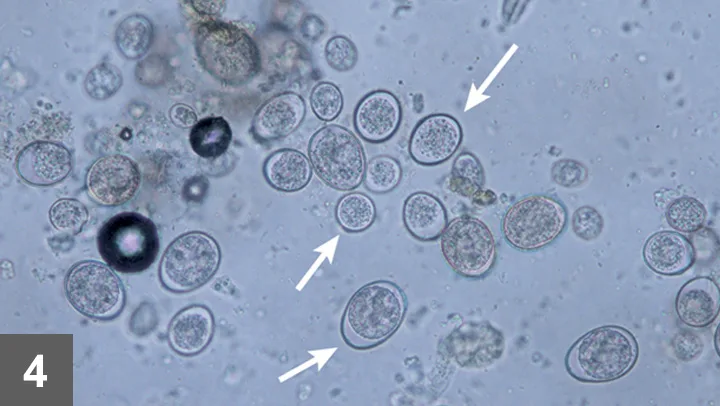
Eimeria spp oocysts, 400× magnification. Several Eimeria species are present in this fecal flotation specimen.
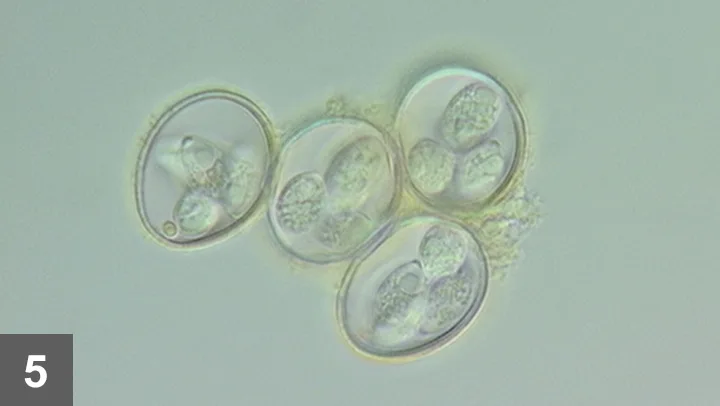
Sporulated Eimeria sp oocysts, 1250× magnification. This infective stage is seen in feces that are not freshly collected.
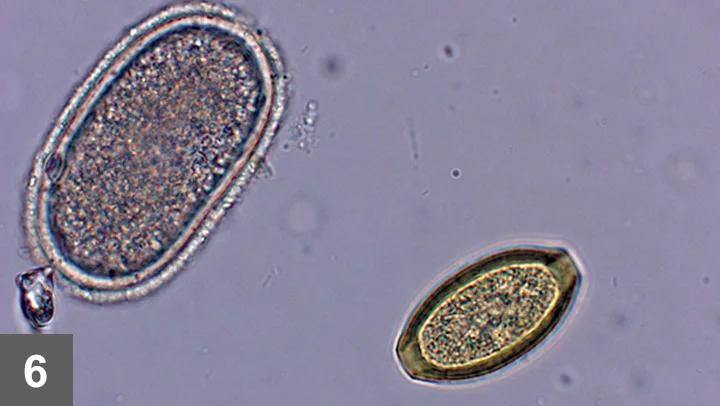
Ascaridia sp (left) and Capillaria sp (right), 40× magnification. These 2 parasite eggs were detected by fecal flotation. Photo courtesy of Michael W. Dryden, DVM, PhD, DACVM, Kansas State University.
Eimeria spp (Coccidia)
Coccidia caused more deaths than all other parasites combined in backyard chickens in California.2
Eimeria spp infect different parts of the intestinal tract and cause varying clinical signs.
Eimeria tenella causes hemorrhage in the cecum.20
Young chickens (<6 weeks of age) are more susceptible to disease and should be kept separate from older chickens or areas where other chickens have been housed during the past year.
Coccidia are species-specific.
Different species of birds will be infected with different species of Eimeria.
Eimeria oocysts will occasionally be detected from fecal examination of cats and dogs that are exposed to the same environment as chickens.
These oocysts are ingested, but they do not infect these animals; they are passed in the feces unaltered.
Davainea proglottina, Raillietina spp (Tapeworms)
Because of the transmission of these parasites by intermediate hosts (eg, ants, snails, slugs, beetles), the prevalence of tapeworms in backyard poultry has the potential to be high.21
Tapeworms may number in the thousands in the small intestine, which can interfere with weight gain and potentially cause catarrhal enteritis.
Motile tapeworm segments may be seen in the fresh feces.
Cleaning of chicken manure and controlling pests can help reduce transmission.
Ascaridia galli (Roundworm)
Ascaridia galli is one of the most common helminth parasites in free-range and backyard chickens.22
In experimentally infected chickens, decreased weight gain was the most common clinical sign.7
Ascaridia galli may increase the susceptibility of chickens to Salmonella spp infection through immune response disturbances and mechanical transmission by migrating larval worms.23,24
Heterakis gallinarum (Cecal Worm)
This parasite is capable of transmitting the disease-causing protozoan Histomonas meleagridis.
Although mortality from H meleagridis mostly occurs in turkey and game birds, chickens can also be affected by this parasite.
Clinical signs are similar to coccidiosis.25
Clients should be advised to house their chickens separate from game birds.
Capillaria (Aonchotheca) caudinflata (Hair Worm)
Moderate-to-severe infections can cause inflammation and sloughing of the intestinal epithelium.26,27
Syngamus trachea (Gape Worm)
These worms live in the trachea and can cause airway irritation and obstruction.26
Management
Depending on the size of the flock, a herd health approach to management of parasites and diseases may be more appropriate than elimination of parasites in individual birds.
Examination and parasite detection can be performed on a subset of birds using pooled samples.
Necropsy can help diagnose a parasite problem in the flock.
Consider submitting specimens to a diagnostician specialized in identifying chicken parasites.
Advise clients to bring newly purchased birds for a thorough examination, and provide education about quarantine procedures.
A local extension service may provide educational materials on biosecurity for backyard-chicken owners.
A 30-day quarantine period is a good practice for avian infectious agents.
Clients should care for the quarantined birds last and use different shoes, clothing, and equipment.
Even if the chickens are kept as pets, backyard flocks are still considered food animals, and appropriate withdrawal times should be followed for all approved medications.
A local veterinary extension specialist or equivalent poultry veterinarian advisor will be a good resource for advice on proper use of pesticides and pharmaceuticals.